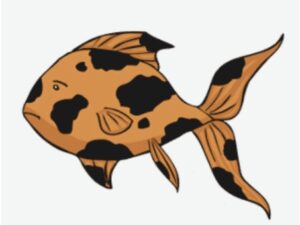The Keyhole Cichlid is a small, peaceful freshwater fish native to South America. It is a popular aquarium fish found in many pet stores. The Keyhole Cichlid gets its name from its head’s distinct “keyhole” shaped mark.
Keyhole Cichlids belong to the Cichlidae family, including other popular aquarium fish such as Oscar fish and angels. It is easy to care for and has a distinctively shaped body. The primary colors of Keyhole Cichlids are green, yellow, and orange.
They are docile and shy, which makes them ideal for community tanks. They are not known to be aggressive and usually get along with other fish. The Keyhole Cichlid is a good choice for beginners because it is easy to care for.
If you are thinking about getting a Keyhole Cichlid, read on to learn everything you need to know about this popular fish.
Table of Contents
- Species Summary
- Keyhole Cichlid Care
- Tank Size
- Water Parameters
- Filtration
- Heating
- Plants
- Lighting
- Fertilizers
- Co2 Systems
- Water Conditioners
- Substrate
- Decorations
- Other Tank Accessories
- Water Changes
- Cleaning The Tank
- Cleaning The Filter
- Adding Keyhole Cichlid To Your Tank
- Testing The Water
- Common Possible Diseases
- Signs That Your Keyhole Cichlid Is Sick
- Preventing Diseases
- Quarantine New Fish
- Test The Water Regularly
- Clean The Tank Regularly
- Do Not Overfeed
- Do Not Overcrowd
- Treatment And Medications Of Diseases
- How To Choose A Healthy Keyhole Cichlid
- Food & Diet
- Diet Foods To Avoid
- The Importance Of A Healthy Diet
- Feeding Schedule
- Keyhole Cichlid Tank Mates
- Fish To Avoid
- Advantages Of Having Keyhole Cichlid In Your Tank
- Disadvantages Of Having Keyhole Cichlid In Your Tank
- Wrapping Up
Species Summary
| Scientific name: | Cleithracara Maronii |
| Common name: | Keyhole Cichlid, orange marbled cichlid |
| Family: | Cichlidae |
| Color Form: | Cream, yellow tint |
| Origin: | South America |
| Adult size: | Up to 4 inches (10 cm) |
| Life expectancy: | 7-10 years |
| Habitat: | These fish are found in slow-moving rivers and streams in South America. |
| Behavior: | Keyhole Cichlids are peaceful and shy. |
| Minimum tank size: | 20 gallons |
| Temperature Range: | 68° – 82°F |
| pH Range: | 5.5-7.5 |
| Water type: | Freshwater |
| Water hardness: | Soft to medium |
| Activity Level: | Moderate |
| Sociability: | Community |
| Tankmates: | Angelfish, Discus, or any Keyhole Cichlids |
| Care level: | Easy |
| Temperament: | Timid and even-tempered |
| Compatibility: | Similar-sized peaceful fish |
| Breeding: | Keyhole Cichlids are egg-layers and will lay their eggs on a flat surface. |
| Diet: | Omnivores |
| Feeding frequency: | 1-2 times a day |
Keyhole Cichlids are native to South America and can be found in slow-moving rivers and streams. The scientific name for this fish is Cleithracara Maronii. The common name, Keyhole Cichlid, comes from the distinct “keyhole” shaped mark on its head.
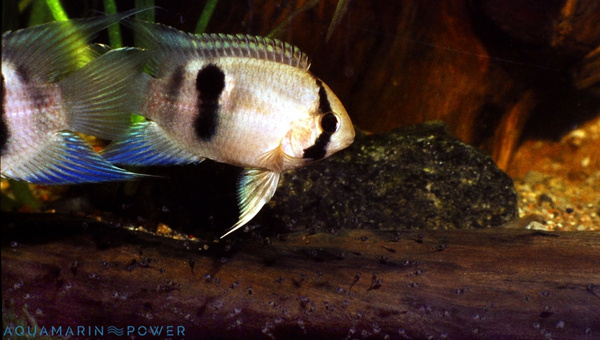
They are primarily found in river basins, including the Amazon, Orinoco, and Paraná. These fish are found in various habitats in the wild, including sandbanks, leaf beds, and submerged logs.
The majority of Keyhole Cichlids within the trade are wild-caught. However, there are a few commercially bred strains available. Most Keyhole Cichlids sold in pet stores are between 2 and 3 inches (5-8 cm) in size.
A Keyhole Cichlid can range from $5 to $20, depending on the size and color. But, on average, you can expect to pay around $10 for one of these fish.
Keyhole Cichlid Size & Growth Rate
The size of a Keyhole Cichlid depends on the sex of the fish. Male Keyhole Cichlids are typically larger than females and can grow up to 4 inches (10 cm). Females are usually smaller, with a maximum size of 3 inches (8 cm).
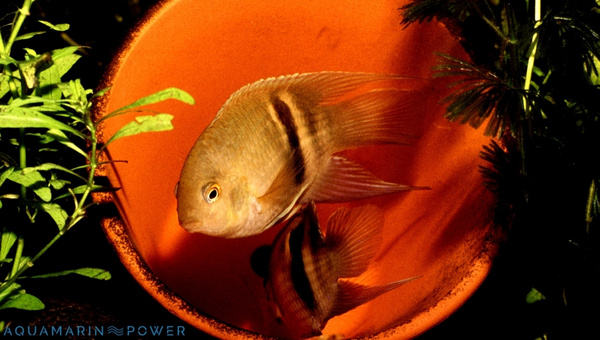
The growth rate of a Keyhole Cichlid is relatively fast. In their first year of life, these fish can grow up to 1 inch (2.5 cm). However, their growth will slow down as they reach adulthood.
Keyhole Cichlid Lifespan
The lifespan of a Keyhole Cichlid is 10 years. However, some fish have been known to live up to 15 years in captivity. The lifespan can be affected by several factors, including diet, water quality, and tank mates.
However, most Keyhole Cichlids die before they reach 10 years old. This is often due to poor water quality or inadequate diet.
Keyhole Cichlid Appearance
The Keyhole Cichlid has a distinctively shaped body. The primary colors of Keyhole Cichlids are green, yellow, and orange. They also have black spots on their bodies and a black stripe running down their side.
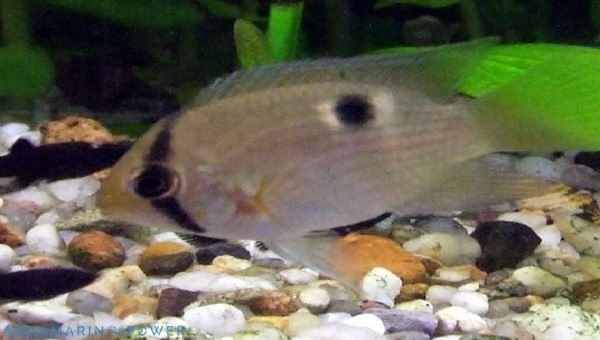
The “keyhole” mark on the head of this fish is unique to each individual. This mark is used to help distinguish between males and females. Male Keyhole Cichlids usually have a more significant and distinct keyhole mark than females.
Females also tend to have rounder bodies than males. The fins of male Keyhole Cichlids are also longer than those of females.
Keyhole Cichlids’ dorsal and anal fins are both pointed. The dorsal fin has 12-14 spines, and the anal fin has 8-10 soft rays. These fish also have a small, triangular mouth. By looking at the mouth of a Keyhole Cichlid, you can tell that they are primarily bottom-dwellers.
Their most distinguishing feature is their laterally compressed body. This unique body shape helps these fish navigate through narrow spaces and find food in small crevices.
These fish also have a well-developed lateral line. The lateral line is a series of pores and tubes that run along a fish’s body length. These pores are connected to the inner ear and help the fish sense movement in the water.
Keyhole Cichlid Behavior & Temperament
Keyhole Cichlids are even-tempered, shy, and peaceful fish. They are a good choice for beginner aquarists. They can be kept in pairs or groups. They should not be kept with fish that are aggressive or much larger than them.
These fish camouflage themselves or “hide” in caves and other dark places in the aquarium. This is why providing them with plenty of hiding places is essential.
They are known to be a little shy at first, but they will eventually become more comfortable and less reclusive.
They only exhibit aggression when breeding. During this time, the females will become very aggressive toward each other. It is essential to provide plenty of space for them to spread out during this time.
They are generally peaceful fish. However, they may nip at the fins of slower-moving fish. They should not be kept with fish that have long, flowing fins.
Males will also become aggressive towards each other during breeding. They will often fight for the attention of the females. It is essential to provide plenty of space for them to spread out during this time.
Keyhole Cichlid Breeding
To breed Keyhole Cichlids, you will need a pair of fish. It is best to choose a male and a female around the same size. The female should be slightly larger than the male.
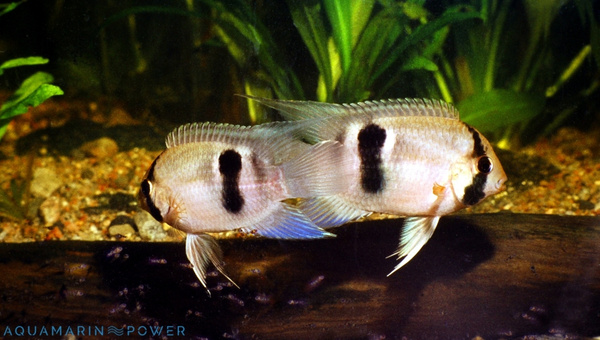
You will also need a breeding tank. The breeding tank should be at least 20 gallons. It should have plenty of hiding places and plants. The water should be clean and well-filtered. The temperature should be between 78° to 82°F.
To set up the breeding tank, follow these steps:
- Choose a tank that is at least 20 gallons.
- Add plenty of hiding places and plants.
- Add a filter and heater.
- Fill the tank with water and let it cycle for at least two weeks.
- After the tank has cycled, add the male and female Keyhole Cichlids.
- Observe the fish for signs of spawning. Spawning usually occurs in the morning. The female will lay a few hundred eggs on a plant or piece of driftwood. The male will then fertilize the eggs.
- After spawning, remove the parents from the tank. The eggs will hatch in 24 to 48 hours.
- The fry will be free-swimming after 7 to 10 days. At this point, you can start feeding them baby brine shrimp or crushed flake food.
- Feed the fry until they are large enough to eat regular food.
Keyhole Cichlid Care
Keyhole Cichlids are peaceful and easy to care for, making them an excellent choice for beginner aquarists. These fish are relatively hardy and can adapt to a wide range of water conditions.
However, providing your Keyhole Cichlid with a well-maintained tank is essential. You will need a larger tank if you keep multiple fish.
Choosing suitable tank mates is also essential. These fish do best with other peaceful, non-aggressive fish.
Avoid keeping them with larger fish, as they may become aggressive or territorial. It’s also essential to provide plenty of hiding places in the tank. These fish like to have lots of plants and rocks to hide behind.
Their diet should consist of various meaty foods and small pieces of fish. You can also give them freeze-dried foods or pellets designed for cichlids.
Here we will discuss everything you need to know about caring for a Keyhole Cichlid, including tank size, diet, water conditions, and more.
Tank Size
The minimum tank size for a Keyhole Cichlid is 20 gallons. However, a larger tank is always better. If you plan on keeping multiple fish, you will need an even larger tank.
When setting up your tank, include plenty of plants and rocks. These fish like to have lots of hiding places.
Water Parameters
Keyhole Cichlids are relatively hardy fish and can adapt to various water conditions. However, it’s essential to maintain good water quality in their tank.
The ideal water temperature for Keyhole Cichlids is 68° to 82°F. The pH should be 5.5 to 7.5, and the water hardness should be 5 to 20 dGH.
The specific gravity of the water is not as important, but it should be in the range of 1.020 to 1.026.
To maintain good water quality, you must do a weekly water change of 30% of the tank volume. You can also use a filter and air pump to help keep the water clean and oxygenated.
Filtration
You will need a filter to keep the water in your tank clean and free of ammonia and nitrites. A canister or hang-on-back filter is a good choice for Keyhole Cichlids.
Be sure to choose a filter with a flow rate appropriate for your tank size. For example, a 30-gallon (114 L) tank will need a filter with a flow rate of at least 100 gallons per hour (gph).
A good filter will not only help keep the water clean, but it will also help to oxygenate the water.
Some recommended filters for Keyhole Cichlids are:
- The Fluval Canister Filter: This filter has a flow rate of 206 gph and is suitable for tanks up to 100 gallons (379 L).
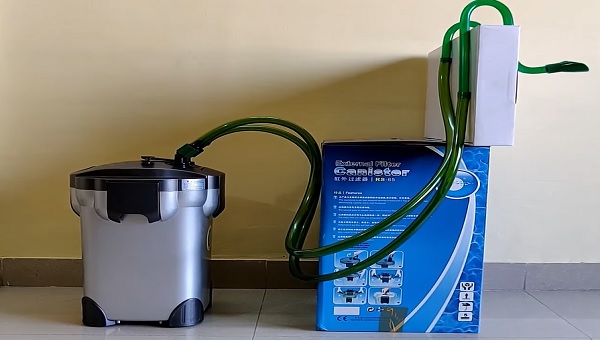
- The Marineland Penguin Power Filter: This filter has a flow rate of 350 gph and is suitable for tanks up to 75 gallons (284 L).
- The AquaClear Hang-on-Back Filter: This filter has a flow rate of 200 gph and is suitable for tanks up to 70 gallons (265 L).
Heating
They prefer water that is 68° to 82°F. If your home is comfortable for humans (around 70°F/21°C), then you probably won’t need to add a heater to the tank.
However, if your home is kept more relaxed than this, or the tank is in an unheated room, you will need to add a heater.
Some recommended heaters for Keyhole Cichlids are:
- The Fluval E Series Heater: This heater has a temperature range of 68°-93°F (20°-34°C) and is suitable for tanks up to 100 gallons (379 L).
- The Tetra aquarium heater: This heater has a temperature range of 65°-93°F (18°-34°C) and is suitable for tanks up to 55 gallons (208 L).
- The Aqueon aquarium heater: This heater has a temperature range of 68°-88°F (20°-31°C) and is suitable for tanks up to 40 gallons (151 L).
Plants
Keyhole Cichlids like to have plenty of plants in their tank. This provides them with hiding places and helps to oxygenate the water and keep it clean.
Some recommended plants for Keyhole Cichlids are:
- Java fern (Microsorum Pteropus): This plant is very easy to care for and can live in many conditions. It can be attached to driftwood or rocks or left to float freely in the tank.
- Anubias (Anubias barteri): This is a low-light plant that can be attached to driftwood or rocks. It is also very easy to care for.
- Java moss (Vesicularia dubyana): This plant can be attached to driftwood or rocks or left to float freely in the tank. It is very easy to care for and does well in low-light conditions.
- Hornwort (Ceratophyllum demersum): This plant can be left to float freely in the tank or planted in the substrate. It is very easy to care for and does well in low-light conditions.
Lighting
They do not require special lighting, but they do prefer dim lighting. A regular fluorescent tube light will be sufficient.
To grow plants in your tank, you will need to use a plant-specific fluorescent tube or LED light.
Some recommended lights for Keyhole Cichlids are:
- The Zoo Med Aquarium Hood: This hood has a fluorescent tube light suitable for plants. It is also available in a version without light if you don’t want to grow plants.
- The Marineland Double Bright LED Light: This light has two LED lights, one for plants and one for viewing the fish. It is suitable for tanks up to 50 gallons (189 L).
- The Aqua Culture LED aquarium hood: This hood has an LED light that is suitable for plants. It is also available in a version without the light if you don’t want to grow plants.
Fertilizers
If you want to grow plants in your tank, you will need fertilizer.
Some recommended fertilizers for Keyhole Cichlids are:
- The Seachem Flourish Tabs: These tablets can be buried in the substrate near plants. They release nutrients over time, which helps to promote plant growth.
- The API Leaf Zone Plant Food: This liquid fertilizer can be added to the tank water. It is rich in iron, which is essential for plant growth.
- The Fluval Plant and Shrimp Stratum: This substrate is enriched with nutrients that are beneficial for plants. It also contains clay, which helps keep plants’ roots healthy.
Co2 Systems
If you want to grow plants in your tank, you will need to use a Co2 system. This will provide the plants with the carbon dioxide they need for photosynthesis.
Some recommended Co2 systems for Keyhole Cichlids are:
- The Fluval Pressurized CO2 Kit: This kit includes everything you need to get started with Co2 injection. It is suitable for tanks up to 100 gallons (379 L).
- The AquaVista 500 Co2 Aquarium Kit: This kit includes everything you need to get started with Co2 injection. It is suitable for tanks up to 500 liters (132 gallons).
- The ADA Mini M CO2 System: This is a very compact Co2 system that is suitable for nano tanks. It is also suitable for larger tanks, but you must purchase additional Co2 cylinders.
Water Conditioners
Using a water conditioner when setting up a new tank is important. This will remove any harmful chemicals from the tap water, making it safe for your fish.
Some recommended water conditioners for Keyhole Cichlids are:
- The API Tap Water Conditioner: This conditioner removes chlorine and chloramine from tap water. It also adds minerals that are beneficial for fish.
- The Seachem Prime Water Conditioner: This conditioner removes chlorine, chloramine, and ammonia from tap water. It also adds a slime coat to the fish, which helps to protect them from infection.
- The Dr. Tim’s Aquatics One and Only Water Conditioner: This conditioner removes chlorine, chloramine, and ammonia from tap water. It also adds minerals and electrolytes that are beneficial for fish.
Substrate
They prefer a sandy substrate. This can be mixed with rocks or driftwood to create a more natural-looking environment.
Some recommended substrates for Keyhole Cichlids are:
- The Caribsea Aquarium Sand: This natural sand is ideal for replicating the African Rift Lake environment.
- The Fluval Plant and Shrimp Stratum: This substrate is enriched with nutrients that are beneficial for plants. It also contains clay, which helps keep plants’ roots healthy.
- The Eco-Complete African Cichlid Mix: This substrate is enriched with minerals and nutrients that are beneficial for cichlids. It also contains live bacteria, which helps to cycle the tank.
Decorations
Keyhole Cichlids like to hide among rocks and driftwood. They also like to dig in the substrate, so you may want to include some plants that can tolerate this.
Some recommended decorations for Keyhole Cichlids are:
- The Seachem Tidal 75 Conch: This naturalistic decoration can be used to create hiding places for fish. It is also safe for aquarium use and will not affect pH or water hardness.
- The Zoo Med Aqua Rock: This naturalistic rock can be used to create hiding places for fish. It is also safe for aquarium use and will not affect pH or water hardness.
- The CaribSea Life Rock: This naturalistic rock can be used to create hiding places for fish. It is also safe for aquarium use and will not affect pH or water hardness.
Other Tank Accessories
There are a few other things that you may want to include in your Keyhole Cichlid tank. These include:
- Aquarium Thermometer: This will help you to keep the tank at the correct temperature.
- Aquarium Test Kit: This will help you monitor the tank’s water quality.
- Ph Meter: This will help keep the pH at the correct level.
- Air Pump: This will help to keep the water oxygenated.
- Co2 Regulator: This will help you control the amount of Co2 in the tank.
Water Changes
It is important to do regular water changes in a Keyhole Cichlid tank. This will help to remove any build-up of toxins in the water and will also replenish any minerals that have been depleted. A good rule of thumb is to do a water change of 25% every 2 weeks.
It also helps to vacuum the substrate during water changes. This will remove any uneaten food or waste accumulated on the bottom of the tank.
To change the water, you will need:
- A siphon will help you remove the water from the tank.
- A bucket will be used to hold the water you remove from the tank.
- The water conditioner will remove any toxins from the water you add to the tank.
The steps to changing water are:
- Remove the lid from the aquarium.
- Place the siphon into the tank and start to siphon out the water.
- When the bucket is half full, stop the siphon and add a water conditioner to the water.
- Continue to siphon the water into the bucket until it is full.
- Pour the water from the bucket into the sink.
- Repeat steps 2-5 until you have removed the desired amount of water from the tank.
- To add new water to the tank, pour it slowly into the aquarium, so you do not disturb the substrate.
- Add water conditioner to the new water before adding it to the tank.
- Replace the lid on the aquarium.
Cleaning The Tank
It is important to keep the Keyhole Cichlid tank clean. This can be done by doing regular water changes and vacuuming the substrate. It is also a good idea to remove any uneaten food or waste from the tank on a daily basis.
This includes cleaning the glass, decorations, and gravel. This will help to remove any build-up of algae or waste from the tank.
To clean the tank, you will need:
- A clean sponge: This will be used to clean the glass.
- A toothbrush: This will be used to clean the decorations.
- A small vacuum: This will be used to vacuum the gravel.
The steps to cleaning the tank are:
- Remove the lid from the aquarium.
- Take out the decorations and clean them with the toothbrush.
- Clean the glass with a sponge.
- Vacuum the gravel with a small vacuum.
- Rinse the decorations and gravel before putting them back into the tank.
- Replace the lid on the aquarium.
Cleaning The Filter
It is important to clean the filter regularly. This will help remove any dirt and debris from the filter. It is a good idea to clean the filter every 2 weeks.
To clean the filter, you will need:
- A clean sponge will be used to wipe down the outside of the filter.
- A toothbrush will be used to scrub the inside of the filter.
The steps to cleaning the filter are:
- Remove the filter from the tank.
- Wipe down the outside of the filter with the sponge.
- Scrub the inside of the filter with the toothbrush.
- Rinse the filter with clean water.
- Replace the filter in the tank.
Adding Keyhole Cichlid To Your Tank
When adding Keyhole Cichlid to your tank, it is important to do so gradually. This will help prevent any sudden changes in water chemistry that could harm the fish.
It is also a good idea to add the fish one at a time and quarantine them before adding them to the main tank. This will help to prevent the spread of disease.
To add a Keyhole Cichlid to your tank, you will need:
- A net This will be used to catch the fish.
- A quarantine tank will be used to house the fish until they are ready to be added to the main tank.
The steps to adding Keyhole Cichlid to your tank are:
- Set up the quarantine tank with the same water parameters as the main tank.
- Acclimate the fish to the quarantine tank by slowly adding water from the main tank to the quarantine tank over a period of 30 minutes.
- When the fish are acclimated, add them to the quarantine tank.
- Observe the fish for any signs of disease for 2 weeks.
- If the fish are healthy, add them to the main tank.
- If the fish are sick, treat them in the quarantine tank and observe for 2 weeks.
- If the fish are still sick after 2 weeks, remove them from the tank and dispose of them properly.
- Repeat steps 1-7 for each fish you add to the tank.
Testing The Water
It is important to test the water regularly. This will help ensure that the water parameters are within the safe range for Keyhole Cichlid.
It is a good idea to test the water at least once a week.
To test the water, you will need:
- A water testing kit will be used to test the water parameters.
The steps to testing the water are:
- Remove a water sample from the tank with a cup or bottle.
- Test the water for ammonia, nitrite, nitrate, pH, and hardness.
- Compare the results to the chart on the back of the water testing kit.
- If the results are not within the safe range, take steps to correct the water parameters.
- Repeat steps 1-4 every week.
Common Possible Diseases
Keyhole Cichlids are a popular type of freshwater fish. They are known for their brightly colored bodies and their playful personalities. While they are relatively hardy fish, they can still succumb to diseases.
Some of the most common diseases that affect them include:
- Ich: Ich is a parasitic infection that causes white spots to form on the fish. It is often fatal if left untreated. In this disease, the fish may also scratch themselves on objects in the tank and have flared fins. It is important to treat ich as soon as possible.
- Cottonmouth: Cottonmouth is a bacterial infection that causes the mouth and gills of the fish to become irritated. The fish may also have swollen fins and trouble breathing. It is important to treat cottonmouth as soon as possible.
- Hole-in-the-Head: Hole-in-the-head is a parasitic infection that causes sores on the fish’s head. The fish may also have swollen fins and trouble breathing. It is important to treat hole-in-the-head as soon as possible.
- Fin rot: Fin rot is a bacterial infection that causes the fish’s fins to rot. The fish may also have red streaks on the body and trouble breathing. It is important to treat fin rot as soon as possible.
- Dropsy: Dropsy is a disease that causes the fish to swell up. The scales of the fish may also stick out. This is often caused by poor water quality or bacterial infection. It is important to treat this disease as soon as possible, as it can be fatal.
- Columnaris: Columnaris is a bacterial infection that causes sores to form on the fish’s body. The fish may also have fins that are frayed or torn. It is important to treat columnaris as soon as possible.
If you notice any of these symptoms in your fish, you must take them to a vet as soon as possible. A vet will be able to properly diagnose and treat the disease.
Signs That Your Keyhole Cichlid Is Sick
You can look for several signs to determine if your Keyhole Cichlid is sick.
Some of the most common include:
- Loss of appetite
- Weight loss
- Fading color
- Fragging fins
- Sores on the body
- Trouble breathing
If you notice any of these signs in your fish, you must take them to a vet as soon as possible. A vet will be able to properly diagnose and treat the disease.
Preventing Diseases
There are several different treatment options available for these diseases. However, the best course of action is prevention. Some of the things that you can do to prevent these diseases include:
Quarantine New Fish
It is important to quarantine new fish before adding them to the main tank. This will allow you to observe them for any signs of disease and treat them before they have a chance to infect the other fish.
Test The Water Regularly
Testing the water regularly will help ensure that the water parameters are within the safe range. This will help to prevent disease.
Clean The Tank Regularly
A clean tank is a healthy tank. Be sure to clean the tank on a regular basis to remove any waste or debris.
Do Not Overfeed
Overfeeding can lead to several health problems in fish. It is important to feed them only as much as they can eat in a few minutes.
Do Not Overcrowd
Overcrowding can lead to several health problems in fish. It is important to have at least 2 gallons of water per fish.
Treatment And Medications Of Diseases
Many different treatments and medications can be used to treat diseases in fish.
Some of the most common include:
- Anti-fungal medication: Anti-fungal medication can be used to treat several different fungal infections.
- Anti-bacterial medication: Anti-bacterial medication can be used to treat several different bacterial infections.
- Anti-parasitic medication: Anti-parasitic medication can be used to treat several different parasitic infections.
It is important to consult with a vet before using any medication. A vet will be able to properly diagnose the disease and prescribe the appropriate medication.
How To Choose A Healthy Keyhole Cichlid
There are several things that you can do to ensure that you are choosing a healthy Keyhole Cichlid. Some of the most important include:
- Observe the fish: The fish should be active and alert. They should have clear eyes and fins.
- Avoid fish with sores or lesions: These are signs of disease, and the fish should be avoided.
- Ask the breeder or store owner about the health of the fish; They should be able to provide you with information on the health of the fish.
Food & Diet
Keyhole Cichlids are omnivores whose diet should consist of plant and animal matter.
Some of the things that you can feed them include:
- Brine shrimp
- Bloodworms
- Daphnia
- Krill
They eat various food in the wild, mainly consisting of detritus, larvae, and small invertebrates.
Feed keyholes are a mix of dried, frozen, and live foods. Look for a quality cichlid pellet as the base diet and supplement with bloodworms, brine shrimp, daphnia, krill & other meaty foods. Algae is also essential to their diet and can be offered as spirulina or blanched vegetables.
It is essential to offer them a variety of different foods to ensure that they are getting all the nutrients they need.
Diet Foods To Avoid
There are several different foods that you should avoid feeding Keyhole Cichlids.
Some of the most common include:
- Canned fish: Canned fish contains high mercury levels, which can harm keyholes.
- Processed meats: Processed meats contain high levels of salt and fat, which can harm keyholes.
- Dairy products: Dairy products contain high levels of lactose which can be harmful to keyholes.
It is important to avoid feeding them these foods as they can cause health problems.
The Importance Of A Healthy Diet
A healthy diet is essential for many different reasons. Some of the most important include: It helps to ensure that the fish are getting all the nutrients they need. It helps to prevent disease. It helps to promote growth and development. A healthy diet is essential in keeping Keyhole Cichlids healthy and happy.
Feeding Schedule
It is essential to feed Keyhole Cichlids regularly. They should be provided two or three times a day. A good rule of thumb is to feed them as much as possible in a few minutes. It is important not to overfeed them as this can lead to health problems.
They should be offered a variety of different foods to ensure that they are getting all the nutrients they need. It is also essential to provide them with food at other times of the day to mimic their natural feeding habits.
Keyhole Cichlid Tank Mates
Keyhole Cichlids need the company of their kind or other peaceful, non-aggressive fish. They should not be kept with fish that are much larger than them or that have long-flowing fins.
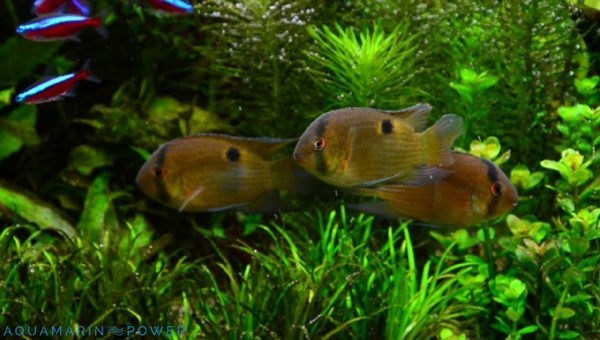
Some good tank mates include:
- Docile cichlid species
- Cory catfish
- Giant Danios
- Hatchetfish
- Mollies
- Platies
- Swordtails
- Tetras such as Black Neon Tetra, Cardinal Tetra, Ember Tetra, Neon Tetra, Green Neon Tetra
The best way to determine if a fish is compatible with Keyhole Cichlids is to research their behavior and temperament.
Fish To Avoid
Some fish are not compatible with Keyhole Cichlids and should be avoided. These include:
Advantages Of Having Keyhole Cichlid In Your Tank
The first advantage is that they are beautiful fish. They have a dark bodies with yellow spots. The male fish also have long, flowing fins. They are peaceful and shy fish that make a great addition to any aquarium.
Another advantage is that they are easy to care for. They are not demanding and can live in a wide range of water conditions. They are also not picky eaters.
A third advantage is that they are easy to breed. They will readily breed in captivity if the conditions are right.
Lastly, they are good beginner fish. They are hardy and can tolerate a wide range of water conditions. They are also peaceful, making them a good choice for those new to the hobby.
Disadvantages Of Having Keyhole Cichlid In Your Tank
The first disadvantage is that they are shy fish. They may not come out much in the open and prefer to stay hidden most of the time.
Another disadvantage is that they need a bit more space than other fish. They should be kept in tanks that are at least 20 gallons.
Lastly, they can be a bit nippy. They may nip at the fins of slower-moving fish. They should not be kept with fish that have long, flowing fins.
Wrapping Up
As you can see, keeping Keyhole Cichlids has both advantages and disadvantages. However, they are good fish for both beginners and experienced aquarists. If you are looking for a peaceful and shy fish that is easy to care for, then the Keyhole Cichlid may be the perfect fish for you!
I hope that this article has helped you to understand them better. If you have any questions, please feel free to comment below.
Thanks for reading!



